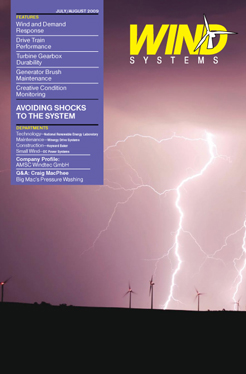Variability and uncertainty have been an inherent part of managing the power system since Westinghouse and Edison built the first central station power plants in the late 1800s. While power system engineers have developed a number of supply-side mechanisms to keep electricity supply and demand in balance during the intervening century, recent technological advances have made it possible to use demand-side assets like demand response (DR) resources for this purpose as well. Though not essential for achieving high levels of wind penetration, smart grid technologies can help grid operators accommodate the incremental variability and uncertainty added by wind energy in a more efficient and cost-effective manner.
Wind Energy and Grid Variability
To understand how demand response and smart grid technologies can facilitate wind integration, it is important to understand how wind energy is integrated with the grid today. Wind energy is a variable resource—its output varies depending on the wind speed. While wind energy output can be predicted with a high degree of accuracy through the use of wind energy forecasting, there is always some uncertainty about future wind output simply because weather systems are not perfectly predictable.
However, it is important to keep in mind that there is already a huge amount of variability and uncertainty on the power grid today, with demand for electricity fluctuating drastically with changes in the weather and supply dropping unexpectedly as power plants experience outages that can instantaneously take 1,000 megawatts or more of supply offline.
Grid operators continuously accommodate this variability and uncertainty by increasing and decreasing the output of flexible generators—power plants such as hydroelectric dams or natural gas plants that can rapidly change their level of generation. These flexible resources are known as “operating reserves.” Instead of backing up each power plant with a second power plant in case the first one suddenly fails, grid operators pool reserves for the whole system to allow them to respond to a variety of potential unexpected events.
System operators use two main types of operating reserves: “spinning reserves” (regulation reserves plus contingency spinning reserves), which can be activated quickly to respond to abrupt changes in electricity supply and demand; and “non-spinning reserves” (including supplemental reserves), which are used to respond to slower changes. Spinning reserves are typically power plants that are held below their maximum output level so that they can rapidly increase or decrease output as needed. Hydroelectric plants and combined cycle natural gas plants are typically the first choice of system operators for spinning reserves because their output can be changed rapidly with only minimal declines in efficiency.
Non-spinning reserves are inactive power plants that can start up within a short period of time (~10-30 minutes), if needed. These are typically hydroelectric or single-cycle natural gas turbines because of their rapid and efficient start-up capabilities. Usually, non-spinning reserves that are made available are not actually used, as they are only activated if there is a large and unexpected change in electricity supply or demand. As a result, the emissions and fuel use associated with slower-response non-spinning reserves are even lower than fast-response spinning reserves. Consequently, slower-response non-spinning reserves are much less expensive than second-to-second spinning regulation reserves. In New York State, for example, 30-minute non-spinning reserves are less expensive by a factor of 50 on average.
The same operating reserves that are used to accommodate non-wind variability and uncertainty are used to accommodate the added variability and uncertainty that comes with high penetrations of wind energy. While adding large amounts of wind energy to the electric grid may make it necessary to increase the quantity of reserves that need to be held ready, the increase in needed reserves is typically modest, in part because changes in aggregate wind generation often cancel out uncorrelated changes in electricity demand.
Dozens of peer-reviewed studies have unanimously concluded that there are no technical barriers to achieving high penetrations of wind energy, but rather only modest increases in system operating costs related to the need to hold additional reserves. These studies have found that the costs of integrating wind energy penetrations of 10-20 percent or more with the electric grid are typically less than half of a cent per kilowatt-hour ($0.005/kWh), or about 10 percent of the average wholesale cost of wind power.
Another reason why these costs are low is that changes in the total energy output from wind turbines spread over a reasonably large area tend to occur very slowly. While occasionally the wind speed may suddenly change at one location and cause the output from a group of turbines to fluctuate rapidly, regions with high penetrations of wind energy tend to have hundreds or thousands of turbines spread over hundreds of miles. As a result, it typically takes many minutes or even hours for the total wind energy output of a region to change significantly. This makes it possible for utility system operators to primarily accommodate wind’s added variability through slower-response non-spinning reserves, which as established above are much less expensive than second-to-second spinning reserves.
These wind integration studies, as well as decades of grid operating experience in European countries with high penetrations of wind energy, unanimously support the conclusion that high penetrations of wind energy can be accommodated through the use of conventional reserves. These studies have concluded that wind integration is a cost issue—not a reliability issue—and there are no technological barriers to achieving higher wind penetrations. That said, smart grid applications such as DR can play a valuable role in making the grid more flexible, thus reducing the cost of accommodating all types of variability, including that introduced by wind energy.
Demand Response Facilitates Economical Integration
Demand response resources are well poised to provide grid operators with low-cost, efficient flexibility to handle variability on the power system, including incremental variability introduced by wind energy.
Demand response is increasingly providing grid operators and utilities with more flexibility in their control rooms. Whereas in the past DR was equated with interruptible tariffs that could rarely be called or relied upon, today’s technology-enabled DR is providing dispatchers with an additional option to address both planned and unforeseen system needs.
As explained previously, wind energy output tends to be relatively constant over periods of time less than 10 minutes, with significant variations only tending to occur over periods of 30 minutes or more. These characteristics match nicely with the capabilities of most demand response resources, making them ideally suited to accommodate the incremental grid variability added by wind energy. Rather than procuring traditional supply-side generation to provide operating reserves, systems planners are better served to procure demand response resources that can provide similar operational characteristics with a smaller environmental footprint and at a lower cost.
Demand response resources have been proven to be able to participate in 10-minute response reserves markets with strenuous rules and performance standards, such as the PJM Interconnection’s Synchronized Reserves Market and the Electric Reliability Council of Texas’s (ERCOT) Load Acting as a Resource program. In fact, most major grid operators are now procuring DR to provide such reserves products. The Independent System Operator of New England (ISO-NE) is continuing its Demand Response Reserves Pilot, and the New York ISO has implemented its Demand Response Ancillary Services Program.
For the rare occurrences when there are large and unexpected fluctuations in electric supply or demand, whether caused by load forecast errors, unanticipated wind fluctuations, or conventional generation or transmission failures, DR again can be of service. Demand response resources played an important role in accommodating unexpected variability on Texas’ power grid on February 26, 2008, when an event was largely caused by an unexpected increase in electricity demand. While initial reports blamed this variability on an unanticipated decrease in wind output, it subsequently became clear that an increase in electricity demand combined with the failure of conventional generation to come online as scheduled were larger contributing factors. Regardless of the cause of the event, demand response resources were deployed and able to quickly and efficiently accommodate the unexpected variability.
Equally important, all major electric grids in the U.S. have significant amounts of emergency demand response resources, able to respond to capacity shortfalls or other system contingencies. While many emergency-based DR programs have day-ahead dispatch options, an increasing number can be activated within 30 minutes or less, such as the ISO-NE Real-Time Demand Response program or ERCOT’s Emergency Interruptible Load Service.
In addition, utilities throughout the country are purchasing DR with characteristics that combine aspects of short-term reserves programs and emergency programs. These programs, sometimes called peaking alternative demand response, are procured in lieu of building a new combustion turbine or signing a power purchase agreement with an independent generator. With response times as short as 10 minutes, and the ability to call the resource for as much as 100 hours per year, these programs are an increasingly common and flexible resource that can serve to complement grid variability in regulated, vertically-integrated utility systems. Importantly, unlike some of the open market programs, which have specific operational triggers, these utility programs often grant significant amounts of flexibility to the control room, giving operators the ability to dispatch these programs at their discretion. Like open-market emergency programs (and unlike spinning/non-spin reserves programs), these utility DR programs can shift loads for hours of time, which is important when addressing forecasting errors.
Future Smart Grid Applications
Further facilitate wind integration in a variety of ways. Most apparent is the ability for technological advancements to improve demand response solutions. While some DR providers today already can automate complex commercial and industrial end-user loads and integrate their control into building management systems, smart grid technology will expand the types and manners of loads that can be controlled. Dynamic control solutions that maximize the amount of DR capacity available and minimize its response time, all while making participation easier and less obtrusive to customers, will ensure that there is an increasing amount of high-quality demand resources able to complement wind.
An additional area where demand-side resources can complement wind energy is by reshaping system load to better match that of the wind resource. With today’s inflexible power system and outdated transmission grid, in many regions the supply of electricity exceeds demand at night or other periods of low demand. This can cause low or even negative power prices, and can force wind generators to curtail their output by pitching the wind turbine blades out of the wind. Wasting free, zero-emissions energy is an undesirable outcome. Demand response tools can help solve this problem by shifting peak energy use to off-peak hours when wind output tends to be higher.
For short periods of low demand and high wind availability, DR technologies can temporarily increase load and utilize the wind resource. For example, cold storage facilities or HVAC systems could be triggered to “pre-cool,” adding demand when there is excess power and reducing the need to cool the building during daytime periods.
Such activity could be “dispatched” like a traditional DR event through new programs or encouraged through new innovative rate structures that pair “smart rates” with smart meters. While many commercial and industrial customers already have interval metering and are exposed to some type of dynamic pricing, almost no residential or small commercial customers are similarly equipped. With advanced metering infrastructure fully deployed, customers of all rate classes can be put on innovative rate structures that discourage consumption when the grid is stressed and encourage it when the grid is not. Consider a critical peak pricing (CPP) rate that also included a wind power pricing (WPP) rate that was activated during periods of low demand and high wind availability. Just as customers on CPP rates see a spike in prices during periods of peak demand, customers on a CPP/WPP rate would also see a reduction in price during particularly gusty periods at night.
Commercial and industrial DR providers would work with their customers to automate load control in response to such price signals, as they do today in response to high prices. In the future, DR providers and homeowners themselves will also likely have more loads available at off-peak times that can be called up—electric vehicles.
In addition to facilitating the deployment and use of DR, smart grid technologies can also be used on the transmission system itself and in power system control rooms to make the grid more flexible and better able to accommodate variability. “Smart” computing and communications technology, including both hardware and software applications, can facilitate the following operational changes that will greatly improve the flexibility of the power system:
• Faster resource dispatch intervals: Scheduling and dispatching power plants and demand response resources for 5-minute, 10-minute, or 15-minute periods, instead of for the hourly periods used in many regions, can greatly reduce the cost of accommodating intra-hour variability on the power system. One wind integration study calculated that 10-minute scheduling reduces wind integration costs by 40 to 60 percent relative to hourly scheduling. Similarly, power flows on transmission lines can be dynamically scheduled to better accommodate intra-hour variability.
• Virtual balancing area consolidation: By allowing excess electricity supply in one region to be netted out with inadequate supply in a neighboring region, the cost of accommodating variability on the grid can be greatly reduced. This is particularly true for regions with high wind penetrations, as changes in wind output in one region are typically not highly correlated with changes in another region.
• Better integration of wind energy forecasting: While current wind energy forecasting techniques are advanced, smart grid technology can help better integrate forecast results into power system operational decisions, allowing reserves to be allocated more efficiently.
• Dynamic line ratings: Ambient weather conditions such as wind speed are not taken into account when calculating the transfer capacity of a transmission line, which decreases as temperature increases. Tension monitors on transmission lines can determine the real-time capacity of a line, and smart grid technology can communicate the results to grid operators. This will allow more power to be safely loaded onto transmission lines during periods when the wind speed is higher, which will also tend to be periods when wind energy output is higher.
Making the Grid Smarter
Policymakers at a variety of levels—including the staff of state Public Utility Commissions, the Federal Energy Regulatory Commission, and the Department of Energy—can play an important role in ensuring that resources and other incentives are directed towards the smart grid technologies that hold the most promise for making our power system cleaner and more efficient. The technologies discussed in this article, namely technologies that facilitate greater use of demand response as well as transmission-level technologies that enhance the flexibility of the power system itself, have tremendous potential for facilitating wind integration while making the power grid more efficient for all users.
References
1) Based on average ancillary services prices from November 13, 2007 to November 12, 2008, available at www.nyiso.com/public/market_data/pricing_data/dam_ancillary.jsp
2) For a library of these studies, see www.uwig.org/opimpactsdocs.html
3) While wind output gradually decreased over the course of several hours that afternoon, wind output was constant, or gradually increasing, over the actual hour when electricity demand began to exceed supply. Moreover, the gradual decrease in wind output was accurately forecast at least a day in advance, but unfortunately the wind forecasting system was only in pilot testing phase and not yet integrated into system operations at that time. For more information, see ERCOT’s report on the incident: interchange.puc.state.tx.us/WebApp/Interchange/Documents/27706_114_577769.PDF
4) See www.uwig.org/AvistaWindIntegrationStudy.pdf.






































